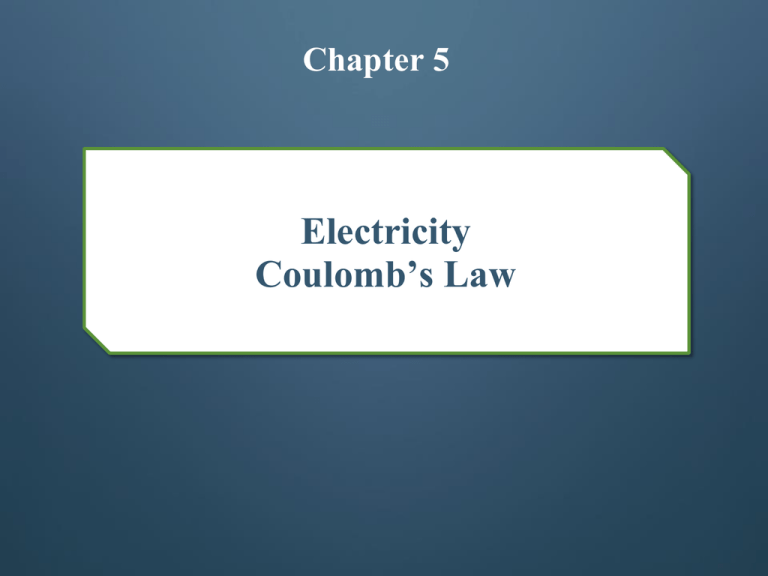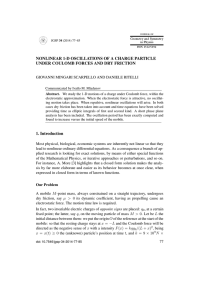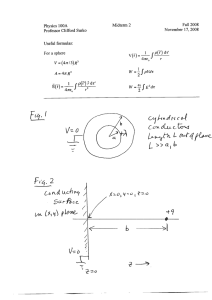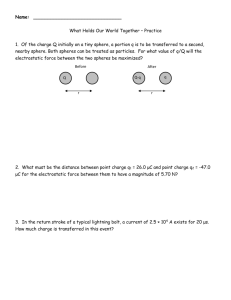
Chapter 5
Electricity
Coulomb’s Law
Electricity
• Electricity is a type of energy that can build up in one place or flow
from one place to another.
• When electricity gathers in one place it is known as static
electricity (the word static means something that does not move)
• electricity that moves from one place to another is called current
electricity.
• Electric charge divided two positive and negative charges
• How electric charges move?
2014 John Wiley & Sons, Inc. All rights reserved.
Coulomb’s Law
Magic?
(a) The two glass rods were each rubbed with a silk
cloth and one was suspended by thread. When they
are close to each other, they repel each other.
(b) The plastic rod was rubbed with fur. When brought
close to the glass rod, the rods attract each other.
What is the method of charging ?
Coulomb’s Law
Electric Charge
(a) Two charged rods of the same sign repel each other.
(b)
Two charged rods of opposite signs attract each
other. Plus signs indicate a positive net charge, and
minus signs indicate a negative net charge.
Coulomb’s Law
Materials classified based on their ability to move
charge
•
Conductors are materials in which a significant number of electrons are free to
move. Examples include metals.
•
The charged particles in nonconductors (insulators) are not free to move.
Examples include rubber, plastic, glass.
•
Semiconductors are materials that are intermediate between conductors and
insulators; examples include silicon and germanium in computer chips.
•
Superconductors are materials that are perfect conductors, allowing charge to
move without any hindrance.
Coulomb’s Law
The magnitude of the electric force between two point charges is directly proportional
to the product of the charges and inversely proportional to the square of the distance
between them.
In mathematical terms, the magnitude 𝑭 of the force that each of two point charges
𝒒𝟏 𝒂𝒏𝒅 𝒒𝟐 a distance𝒓 apart exerts on the other can be expressed as :
𝒒𝟏 𝒒𝟐
𝑭𝑬 = 𝒌. 𝟐
𝒓
𝐹𝐸 = electrostatic force (newtons)
2
𝑚
𝑘 = 8.9 × 109 𝑁. 2
𝐶
𝑞1 = charge of first particle (coulombs)
𝑞2 = charge of second particle (coulombs)
𝑟 = 𝑑𝑖𝑠𝑡𝑎𝑛𝑐𝑒 𝑏𝑒𝑡𝑤𝑒𝑒𝑛 𝑡ℎ𝑒 𝑐ℎ𝑎𝑟𝑔𝑒𝑠 (𝑚)
Coulomb’s Law
Coulomb’s Law
Coulomb’s law describes the electrostatic force (or
electric force) between two charged particles. If the
particles have charges q1 and q2, are separated by
distance r, and are at rest (or moving only slowly)
relative to each other, then the magnitude
of the force acting on each due to the other is
given by
The electrostatic force on particle 1 can
be described in terms of a unit vector r
along an axis through the two particles,
radially away from particle 2.
Coulomb’s Law
Coulomb’s Law
• The electrostatic force vector acting on a charged
particle due to a second charged particle is either
directly toward the second particle (opposite signs
of charge) or directly away from it (same sign of
charge).
• If multiple electrostatic forces act on a particle,
the net force is the vector sum (not scalar sum) of
the individual forces.
Two charged particles repel each other if
they have the same sign of charge, either
(a) both positive or (b) both negative. (c)
They attract each other if they have
opposite signs of charge.
Coulomb’s Law
Multiple Forces: If multiple electrostatic forces act on a particle, the net force is the
vector sum (not scalar sum) of the individual forces.
Shell Theories: There are two shell theories for electrostatic force
Answer: (a) left towards the electron
(b) left away from the other proton
(c) left
Coulomb’s Law
Example 1: A point charge of +3.00 × 10−6 𝐶 is 12.0 cm distant from a second
point charge of −1.50 × 10−6 𝐶 . Calculate the magnitude of the force on each
charge.
Solution:
2
−6 𝐶 1.50 × 10−6 𝐶
𝑞1 𝑞2
𝑚
+3.00
×
10
𝐹𝐸 = 𝑘. 2 = 8.9 × 109 𝑁. 2 .
𝑟
𝐶
(12.0 × 10−2 𝑚)2
= 2.81 𝑁
Example 2:What must be the distance between point charge 𝑞1 = 26.0 𝜇𝐶 and
point charge 𝑞2 = −47.0 𝜇𝐶 for the electrostatic force between them to have a
magnitude of 5.70 N?
Solution:
2
−6 26 × 10−6
𝑞1 𝑞2
𝑞
𝑞
𝑚
47
×
10
1
2
𝐹𝐸 = 𝑘. 2 ⇒ 𝑟 2 = 𝑘.
= 8.9 × 109 𝑁. 2 .
𝑟
𝐹
𝐶
5.70
∴ 𝑟 2 = 1.93 𝑚2 ⇒ 𝑟 = 1.93𝑚2 = 1.39 𝑚
Example (H.W.) 3: The magnitude of the electric force between two protons is
Example 4: The following three charges are arranged as shown. Determine the net
force acting on the charge on the far right (q3 = charge 3).
Solution :
𝑞1 𝑞3
𝑚2
1.5 × 10−7 𝐶 −3.5 × 10−4 𝐶
9
𝐹𝐸 = 𝑘. 2 = 8.9 × 10 𝑁. 2 .
𝑟
𝐶
(3.1 𝑚)2
= −4.9 × 10−2 𝑁
2
−7 𝐶 −3.5 × 10−4 𝐶
𝑞2 𝑞3
𝑚
−2.3
×
10
𝐹𝐸 = 𝑘. 2 = 8.9 × 109 𝑁. 2 .
𝑟
𝐶
(1.7 𝑚)2
= 2.5 × 10−1 𝑁
∴ 𝑭𝑵𝒆𝒕 = −4.9 × 10−2 𝑁 + 2.5 × 10−1 𝑁 = 2.0 × 10−1 𝑁
Charge is Quantized
• Electric charge is quantized (restricted to certain values).
• The charge of a particle can be written as ne, where n is a positive or negative integer
and e is the elementary charge. Any positive or negative charge q that can be detected
can be written as
in which e, the elementary charge, has the approximate value
The charges and masses of the electron, proton and neutron are given in Table:
charge and mass of the Electron, Proton and Neutron
Particle
Charge (C)
Mass (kg)
𝐄𝐥𝐞𝐜𝐭𝐫𝐨𝐧 (𝐞)
−𝟏. 𝟔𝟎𝟐𝟏𝟕𝟔𝟓 × 𝟏𝟎−𝟏𝟗
𝟗. 𝟏𝟎𝟗𝟒 × 𝟏𝟎−𝟑𝟏
𝐏𝐫𝐨𝐭𝐨𝐧 (𝐩)
+𝟏. 𝟔𝟎𝟐𝟏𝟕𝟔𝟓 × 𝟏𝟎−𝟏𝟗
𝟏. 𝟔𝟕𝟐𝟔𝟐 × 𝟏𝟎−𝟐𝟕
𝐍𝐞𝐮𝐭𝐫𝐨𝐧 (𝐧)
𝟎
𝟏. 𝟔𝟕𝟒𝟗𝟑 × 𝟏𝟎−𝟐𝟕
Charge is Quantized
When a physical quantity such as charge can have only discrete values
rather than any value we say that the quantity is quantized. for
example, to find a particle that has no charge at all or a charge of +10e
or -6e, but not a particle with a charge of, say, 3.57e.
Example1 :
What is the charge of an object losses 5000 electrons?
Q = ne = ( -5000 ) (-1.6 x 10-19 )
= 8 x 10-16 c
HW#
What is the charge of an object gain 3000 electrons?
The Electric Field
?
How does particle 1 “know” of the presence of particle 2? That is, since the particles do
not touch, how can particle 2 push on particle 1—how can there be such an action at a
distance?
The Electric Field
Electric Field
The electric field E at any point is defined in terms of the electrostatic force F that
would be exerted on a positive test charge q0 placed there:
𝑭𝑬 = 𝒒𝑬
⇒
𝑭𝑬 𝑵
𝒒
𝑬=
𝑬 = 𝒌. 𝟐
𝒒 𝑪
𝒓
𝑬=𝒌
𝒒𝒊
𝟐
The Electric Field
Electric Field Lines
The Electric Field
Electric Field Lines
(1) The electric field vector at any given point
must be tangent to the field line at that point
and in the same direction, as shown for one
vector.
(2) A closer spacing means a larger field
magnitude.
Field lines for two particles with
equal positive charge. Doesn’t the
pattern itself suggest that the particles
repel each other?
The Electric Field
Example 1: what is the magnitude and direction of the electric field 1 cm above a 𝟐𝟒𝝁𝑪 charge?
Solution:
Note: 𝑚𝑖𝑐𝑟𝑜 𝜇 = 10−6 ,
𝑟 = 1 𝑐𝑚 =
1
100
= 0.01 𝑚
𝒒
𝑵𝒎𝟐 (𝟐𝟒 × 𝟏𝟎−𝟔 𝑪)
𝑵
𝟗
𝟗
𝑬 = 𝒌. 𝟐 = 𝟗 × 𝟏𝟎
.
=
𝟐.
𝟏𝟔
×
𝟏𝟎
𝑪
𝑪
𝒓
(𝟎. 𝟎𝟏 𝒎)𝟐
Example 2: what is strength of the electric field 𝟏 𝒎𝒎 a way from a 𝟑𝟖𝝁𝑪 charge? if a 𝟐𝝁𝑪 charge is
placed in this field at this distance , what will be the force on it?
Solution :
𝑟 = 1 𝑚𝑚 =
1
= 0.001 𝑚
1000
𝒒
𝑵𝒎𝟐 (𝟑𝟖 × 𝟏𝟎−𝟔 𝑪)
𝑵
𝟗
𝟏𝟏
𝑬 = 𝒌. 𝟐 = 𝟗 × 𝟏𝟎
.
=
𝟑.
𝟒𝟐
×
𝟏𝟎
𝑪
𝑪
𝒓
(𝟎. 𝟎𝟎𝟏 𝒎)𝟐
𝑭 = 𝒒𝑬 = 𝟐 × 𝟏𝟎−𝟐 𝑪
𝟑. 𝟒𝟐 × 𝟏𝟎𝟏𝟏
𝑵
⇒ 𝑭 = 𝟔𝟖𝟒𝟎𝟎𝟎 𝑵
The Electric Field
Example (H.W.) 3: What is the magnitude of the electric field 𝐸 at a field point
𝑁
2.0 𝑚from a point charge 𝑞 = 4.0 𝑛𝐶?
Ans. 9.0 𝐶
Note : 𝑛𝑎𝑛𝑜 𝑛 = 10−9
Example 4: At what distance from a positive charge of
electric field strength be 3.91 × 103
𝑁
𝐶
8.421 𝜇𝐶
?
Solution :
𝒓 =?
𝑞 = 8.421 𝜇𝐶𝐸 = 3.91
× 103
𝑬 = 𝒌.
𝒒
𝒓𝟐
⟹ 𝒓𝟐 = 𝒌.
𝒓=
𝒌. 𝒒
=
𝑬
𝑁
𝐾 = 9 × 109
𝐶
𝒒
𝑬
𝟗 × 𝟏𝟎𝟗 (𝟖. 𝟒𝟐𝟏 × 𝟏𝟎−𝟔 𝑪)
=
𝑵
(𝟑. 𝟗𝟏 × 𝟏𝟎𝟑 𝑪 )
would the
Electric Potential
Electric Potential :
the capacity of an electric field to do wok on an electric
charge
© 2014 John Wiley & Sons, Inc. All rights reserved.
Example 1:
© 2014 John Wiley & Sons, Inc. All rights reserved.
Example 2:
© 2014 John Wiley & Sons, Inc. All rights reserved.
The capacitance
© 2014 John Wiley & Sons, Inc. All rights reserved.
The capacitance
The capacitance 𝐂 : of a capacitor is defined as the ratio of the magnitude of the charge on either
conductor to the magnitude of the potential difference between the conductors:
𝐶=
𝑄 𝐶
= 1𝐹𝑎𝑟𝑎𝑑 (𝐹)
∆𝑉 𝑉
Potential and Capacitance :𝑱
𝑪
𝒎𝒂𝒈𝒏𝒊𝒕𝒖𝒅𝒆 𝒐𝒇 𝒄𝒉𝒂𝒓𝒈𝒆 𝒐𝒏 𝒆𝒊𝒕𝒉𝒆𝒓 𝒄𝒐𝒏𝒅𝒖𝒄𝒕𝒐𝒓
𝐂𝐚𝐩𝐚𝐜𝐢𝐭𝐚𝐧𝐜𝐞 =
𝒎𝒂𝒈𝒏𝒊𝒕𝒖𝒅𝒆 𝒐𝒇 𝒑𝒐𝒕𝒆𝒏𝒕𝒊𝒂𝒍 𝒅𝒊𝒇𝒇𝒆𝒓𝒆𝒏𝒄𝒆 𝒃𝒆𝒕𝒘𝒆𝒆𝒏 𝒄𝒐𝒏𝒅𝒖𝒄𝒕𝒐𝒓𝒔
𝟏 𝑽𝒐𝒍𝒕 𝑽 = 𝟏
The capacitance
𝑪𝒆𝒒 = 𝑪𝟏 + 𝑪𝟐 + 𝑪𝟑
(𝒑𝒂𝒓𝒂𝒍𝒍𝒆𝒍 𝒄𝒐𝒎𝒃𝒊𝒏𝒂𝒕𝒊𝒐𝒏)
𝟏
𝟏
𝟏
𝟏
=
+
+
𝑪𝒆𝒒 𝑪𝟏 𝑪𝟐 𝑪𝟑
(𝒔𝒆𝒓𝒊𝒆𝒔 𝒄𝒐𝒎𝒃𝒊𝒏𝒂𝒕𝒊𝒐𝒏)
Example 1: What is the charge on a 𝟑𝟎𝟎 𝒑𝑭 capacitor when it is charged to a voltage of
𝟏. 𝟎 𝒌𝑽?
Solution:
𝐶=
𝑞
⟹ 𝑞 = 𝐶𝑉 = 300 × 10−12 𝐹 1000 𝑉 = 3.0 × 10−7 𝐶 = 0.30 𝜇𝐶
𝑉
Example 2: A metal sphere mounted on an insulating rod carries a charge of 𝟔. 𝟎 𝒏𝑪 when its
potential is 𝟐𝟎𝟎 𝑽 higher than its surroundings. What is the capacitance of the capacitor formed
by the sphere and its surroundings?
Solution:
𝐶=
𝑞
⟹𝐶=
6.0 × 10−9 𝐶
= 30 𝑝𝐹
The capacitance
Example 3:
1) A capacitor of capacitance 𝟓 𝝁𝑭 is connected to 𝟔 𝑽 supply. What charge is stored in the
capacitor?
Answer: 𝟑𝟎 𝝁𝑭
2) A 𝟒𝟎𝟎 𝒑𝑭 capacitor carries a charge of 𝟐. 𝟓 × 𝟏𝟎−𝟖 𝑪. What is potential different across
the plates of the capacitor?
Answer: 𝟔𝟐. 𝟓 𝑽
Example 4:
a) Three capacitors (2.00 𝜇𝐹, 5.00 𝜇𝐹 𝑎𝑛𝑑 7.00 𝜇𝐹) are connected in series. What is their
equivalent capacitance? Ans. 𝟏. 𝟏𝟗 𝝁𝑭
b) Three capacitors (2.00 𝜇𝐹, 5.00 𝜇𝐹 𝑎𝑛𝑑 7.00 𝜇𝐹) are connected in Parallel. What is their
equivalent capacitance? Ans. 𝟏𝟒 𝝁𝑭
Electric Current
As Fig. (a) reminds us, any isolated conducting loop—regardless
of whether it has an excess charge — is all at the same potential.
No electric field can exist within it or along its surface.
If we insert a battery in the loop, as in Fig. (b), the conducting
loop is no longer at a single potential. Electric fields act inside the
material making up the loop, exerting forces on internal charges,
causing them to move and thus establishing a current. (The
diagram assumes the motion of positive charges moving
clockwise.)
Figure c shows a section of a conductor, part of a conducting loop
in which current has been established. If charge dq passes
through a hypothetical plane (such as aa’) in time dt, then the
current i through that plane is defined as
(c)
Electric Current
Figure (a) shows a conductor with current i0 splitting
at a junction into two branches. Because charge is conserved, the
magnitudes of the currents in the
branches must add to yield the magnitude of the current
in the original conductor, so that
Figure (b) suggests, bending or reorienting the wires in space
does not change the validity of the above equation Current arrows
show only a direction (or sense) of flow along a conductor, not a
direction in space.
a movement or flow of electrically charged
particles, typically measured in amperes.
Answer: 8A with arrow
pointing right
Electric Current
HW #
If the electric current flowing in the conductor is 0.3A
compute the magnitude of the charge pass throw Through the
conductor in 2s ؟
© 2014 John Wiley & Sons, Inc. All rights reserved.








